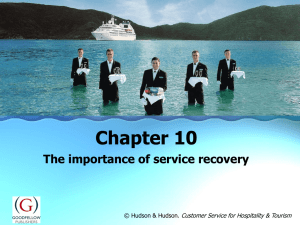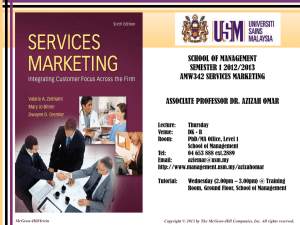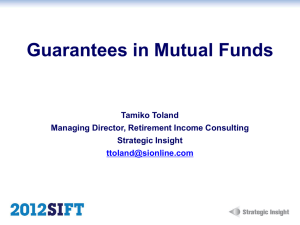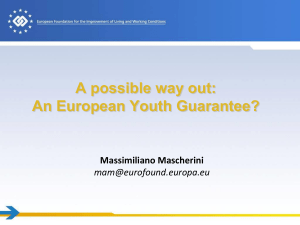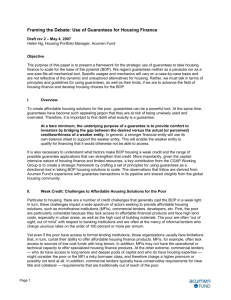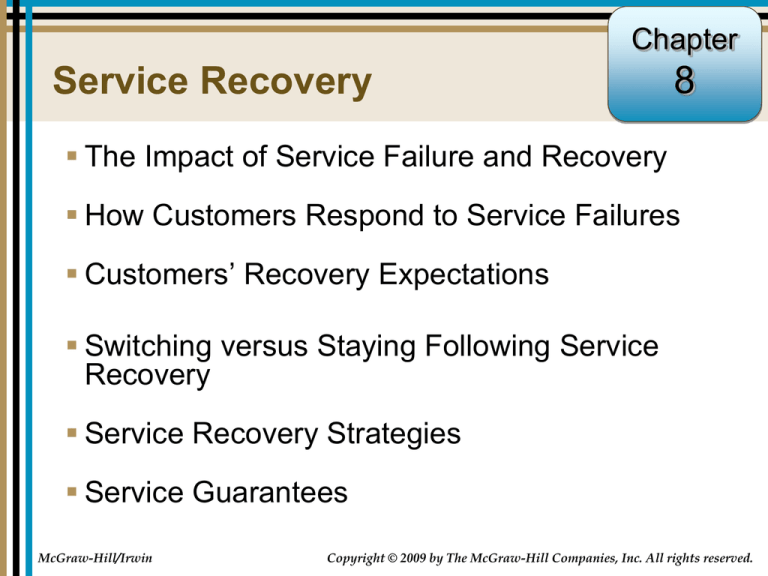
Chapter8-1
Service Recovery
8
The Impact of Service Failure and Recovery
How Customers Respond to Service Failures
Customers’ Recovery Expectations
Switching versus Staying Following Service
Recovery
Service Recovery Strategies
Service Guarantees
McGraw-Hill/Irwin
Copyright © 2009 by The McGraw-Hill Companies, Inc. All rights reserved.
Objectives for Chapter 8:
Service Recovery
Illustrate the importance of recovery from service failures in
keeping customers and building loyalty.
Discuss the nature of consumer complaints and why people do
and do not complain.
Provide evidence of what customers expect and the kind of
responses they want when they do complain.
Present strategies for effective service recovery, together with
examples of what does and does not work.
Discuss service guarantees—what they are, the benefits of
guarantees, and when to use them—as a particular type of
service recovery strategy.
8-2
8-3
Reliability is Critical in Service but…
In all service contexts, service failure is inevitable.
Service failure occurs when service performance
that falls below a customer’s expectations in such
a way that leads to customer dissatisfaction.
Service recovery refers to the actions taken by a
firm in response to service failure.
Complaining Customers:
The Tip of the Iceberg
8-4
Unhappy Customers’ Repurchase
Intentions
8-5
8-6
Dissatisfied Consumers’ Behavior
The Retail Customer Dissatisfaction Study 2006 by
the Verde Group found:
48% of respondents reported that they avoided a store
because of someone else’s negative experience
for those who encountered problems, 33% said they
would “definitely not” or “probably not” return
The exponential power of storytelling:
as people tell the story, the negativity is embellished and
grows
8-7
Customer Rage Study Conducted by
In collaboration with
8-8
How Customers Expressed Their Displeasure
Expressions of displeasure
Respondents Problem
Shared the story with my friends/other people
85%
Complained to the org. that caused the problem1
84%
Decided I'd never do business/come back again
59%
Threatened to talk with/contact management
55%
Yelled or raised my voice
Threatened to report the org. that caused the
problem to a gov't regulatory agency
24%
Threatened legal action
7%
Threatened to contact the media
6%
6%
Cursed/used profanity
16%
8-9
What Customers Wanted to Get
Wanted to get
Product repaired/service fixed
Explanation of why problem occurred
Assurance problem wouldn't be repeated
Apology
Chance to vent
Money back
Free product or service in the future
Financial compensation for my lost time,
inconvenience or injury
Revenge -- make them pay for the hassle
and inconvenience
Other
Respondents Problem
85%
78%
78%
59%
58%
49%
30%
23%
11%
9%
Nonmonetary
remedies
8-10
What Complainants Got:
56% of complainants felt they got
NOTHING
Ping-Ponging (Number of Contacts
Needed to Resolve Complaint)
100%
Mean number of contacts
Complainants = 4.3
% complainants
80%
60%
40%
18%
18%
21%
19%
20%
11%
7%
6%
0%
One
Two
Three
Four
Five
Six
Seven or
more
8-11
8-12
Length of Time to Resolve
Complaints
100%
% complainants
80%
60%
46%
40%
19%
15%
20%
4%
7%
5%
3%
0%
Immed.
Less than 1
day, but not
immed.
1-7 days
8-14 days
15-28 days
28 + days
Still not
resolved
8-13
Fairness Themes in Service Recovery
Customer Complaint Actions Following
Service Failure
8-14
8-15
Service Recovery Paradox
“A good recovery can turn angry, frustrated
customers into loyal ones. ..can, in fact, create
more goodwill than if things had gone smoothly in
the first place.” (Hart et al.)
HOWEVER:
only a small percent of customers complain
service recovery must be SUPERLATIVE
only with responsiveness, redress, and empathy/courtesy
only with tangible rewards
even though service recovery can improve satisfaction, it
has not been found to increase purchase intentions or
perceptions of the brand
service recovery is expensive
8-16
Service Recovery Paradox
The service recovery paradox is more likely to
occur when:
the failure is not considered by the customer to be
severe
the customer has not experienced prior failures with the
firm
the cause of the failure is viewed as unstable by the
customer
the customer perceives that the company had little
control over the cause of the failure
Conditions must be just right in order for the
recovery paradox to be present!
8-17
Causes Behind Service Switching
8-18
Service Recovery Strategies
8-19
Eight Most Common Remedies
Customers Seek with Serious Problems
Have the product repaired or service fixed
Be reimbursed for the hassle of having
experienced a problem
Receive a free product or service in the future
Explanation by the firm as to what happened
Assurance that the problem will not be repeated
A thank you for the customer’s business
An apology from the firm
An opportunity for the customer to vent his or her
frustrations to the firm
Customer Satisfaction with Timeliness of
Firm Responses to Service Failures
8-20
8-21
Service Guarantees
guarantee = an assurance of the fulfillment of a condition
(Webster’s Dictionary)
in a business context, a guarantee is a pledge or
assurance that a product offered by a firm will perform as
promised and, if not, then some form of reparation will be
undertaken by the firm
for tangible products, a guarantee is often done in the form
of a warranty
services are often not guaranteed
cannot return the service
service experience is intangible (so what do you guarantee?)
The Hampton Inn 100 Percent
Satisfaction Guarantee
8-22
Characteristics of an Effective
Service Guarantee
8-23
Unconditional
the guarantee should make its promise unconditionally – no strings
attached
Meaningful
the firm should guarantee elements of the service that are important
to the customer
the payout should cover fully the customer’s dissatisfaction
Easy to Understand and Communicate
customers need to understand what to expect
employees need to understand what to do
Easy to Invoke and Collect
the firm should eliminate hoops or red tape in the way of accessing
or collecting on the guarantee
8-24
Benefits of Service Guarantees
A good guarantee forces the company to focus on its customers.
An effective guarantee sets clear standards for the organization.
A good guarantee generates immediate and relevant feedback from
customers.
When the guarantee is invoked there is an instant opportunity to
recover, thus satisfying the customer and helping retain loyalty.
Information generated through the guarantee can be tracked and
integrated into continuous improvement efforts.
Employee morale and loyalty can be enhanced as a result of having a
service guarantee in place.
A service guarantee reduces customers’ sense of risk and builds
confidence in the organization.
8-25
British Airways Guarantee
8-26
Why a Good Guarantee Works
forces company to focus on customers
sets clear standards
generates feedback
forces company to understand why it failed
builds “marketing muscle”
8-27
Does everyone need a service guarantee?
Reasons companies might NOT want to
offer a service guarantee:
existing service quality is poor
guarantee does not fit the company’s image
too many uncontrollable external variables
fears of cheating or abuse by customers
costs of the guarantee outweigh the benefits
customers perceive little risk in the service
customers perceive little variability in service
quality among competitors
8-28
Service Guarantees
service guarantees work for companies who are
already customer-focused
effective guarantees can be BIG deals – they put
the company at risk in the eyes of the customer
customers should be involved in the design of
service guarantees
the guarantee should be so stunning that it comes
as a surprise – a WOW!! factor
“it’s the icing on the cake, not the cake”


